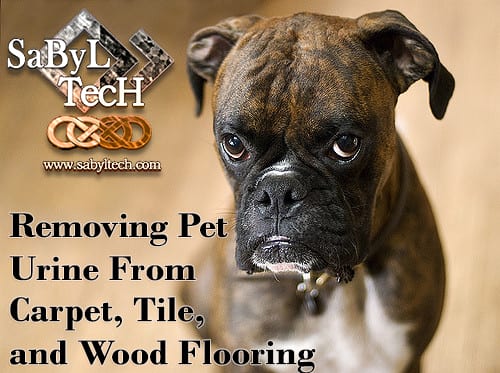Cleaning up an occasional mess comes with the territory when owning a pet. We’ve put together some tips to help you keep your pet friendly home looking and smelling it’s best!

Whether your home is a puppy’s new forever home, or your journey with an old friend is nearing the end, pet accidents can, and will eventually happen.
And when they do, locating and cleaning it up as soon as possible is the best thing that you can do. How you approach the mess depends less on “what” the mess is, and more on “where” the mess is… specifically, what kind of flooring. Different cleaning methods may be more or less effective depending on where the accident happened.
Find The Accident
There’s usually no guessing where an accident has occurred thanks of our senses of sight and smell.
We can also use our sense of touch to occasionally find one when walking barefoot through a dark hallway to use the bathroom…
at around 3 in the morning…
causing us to hop on one foot to the sink…
in the dark…
or so I’ve heard.

On the other hand, it’s fairly common to have a customer bring me into a room with an odor problem that has no obvious signs of pet issues. They’ll usually point in a general area, confident that’s where the smell is coming from.
Much earlier in my career, I can’t tell you how many times I stuck my nose directly onto a carpet trying to find the source of an odor. However, I can tell you that certain smells stick with you for hours, and there isn’t a lot that you can do to make them go away.
One thing is for certain, technology has come a long way (or at least my experience with pet odor has), and I’m about to make sure that you never have to experience the 8 hours of joy that successfully sniffing out pet urine the hard way brings.
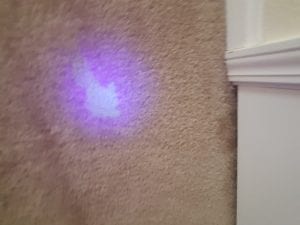
My tool of choice for sniffing out organic fluid spots (urine) these days is a UV light, or flashlight fitted with black-light. These help locate hidden sources of odor because UV light illuminates protein stains. Bodily fluids glow under black light even when they’ve dried, or have been “cleaned”, as is shown in the above photo.
These lights can be bought online or from a pet store, and you can use a fluorescent black light from any novelty store to achieve a similar effect. Even when there is no noticeable odor, it’s a good idea for pet owners to turn off the lights and scan the home with a black light occasionally.
I’ve discovered pet issues beneath furniture, in a lower cupboard, and in the back of a closet in the past when not a single one was was found in any open areas. It was a shock to my client, and obvious that their pet was trying to hide it.

Regardless of how you find it, once a pet spot has been located, a complete and thorough cleaning should not be considered optional. I’m not going to tell you to throw away the 16 ounces of “magic spotter” that you picked up at the pet store right now, but I will say that it’s impossible for it to work as advertised.
Cleaning your carpet, tile, and wood flooring involves different products and procedures in the first place, but urine is the king of technical problems. The process that urine goes through from when the accident first happens, to drying, to setting on your floor is a complex one, and would be difficult to fully explain in this basic spotting guide.
A Little Science… Sorry, But Bear With Me
The ph scale is how we measure if something is acidic, neutral, or alkaline. It goes from 1 to 14, with the lower numbers being acidic and the higher numbers being alkaline. Right in the middle at 7 is neutral. Think of it as a teeter totter with 7 right in the middle… if it goes down to the left, it’s acid. If it goes to the right, alkaline.
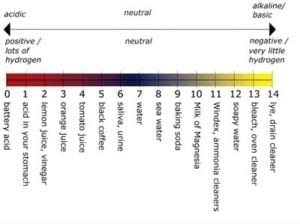
You’ve no doubt heard the buzz words: enzymes, ph, alkaline, acid, organic, bio-chemical… on and on. The truth is that these are all important factors when dealing with urine, but urine is a bit of a… shape-shifter. That’s to say, it literally changes. When your pet has an accident, the ph of the urine is slightly acidic.
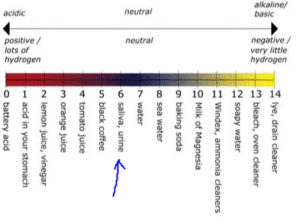
At this point, urine clean-up is focused on bacteria, which is what causes that general “pee smell”. At the same time this is happening, other impurities in this “acidic” urine are bonding to the materials around them, absorbing into them and changing their color to more of a yellowish hue. This is when enzymes are effective because enzymes weaken the bacteria by changing it’s shape and making it easier to remove. To put it an easier way, bacteria can’t hold on as tight, and is easily pulled or rinsed out once the enzyme has clobbered it.
Here’s the fun part: Urine quickly dries, and it’s ph moves up the ph scale from acidic to alkaline as it does. Urine quite literally turns into super pee. If you would’ve told me 10 years ago that I’d be typing that with a straight face…
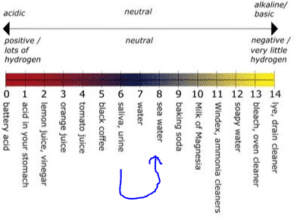 Dry urine has a new ph.
Dry urine has a new ph.
Now you’ve done it. Urine isn’t wet anymore, you’ve fed it after midnight, and it’s ruining Christmas!!!
…Or, it’s ph has shifted. Either way, bacteria is still causing an odor issue, but now salt crystals are forming in the urine and they’re releasing a gas into the air. This gas creates the “strong urine smell” that you’re suddenly thinking of all too vividly. This is that very heavy, pungent, overbearing smell.
These stinky salt crystals eat your enzyme spotter for lunch, and share a ph level with your baking soda DIY mix from the internet. They have no respect for your vinegar hack either, as that just tickles bacteria-phase urine.
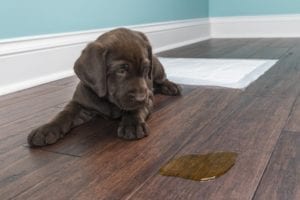
I don’t want to confuse you. I only want to make it clear that the truth IS a confusing topic… at least at first. Pet urine is one of the trickiest problems to solve, and knowing the science is what separates the good from the bad in the cleaning industry. Big-name companies sell “odor eliminating” pet products in every pet and grocery store possible, all the while being completely aware that their claims of “odor elimination” are impossible with a single bottle of liquid.
In “Big Pet Store”‘s estimation, you are statistically more likely to catch your pet in the process of peeing on the floor than you are to find it later once it has dried. You will then use their product right away when an “enzyme” will be most effective, and abracadabra… it’s a miracle!
This is why the word “enzyme” is thrown around and marketed as “the cure to pet spots”… after all, the product works, right? Well… kind of, but this is also why people who rely solely on those products usually have a pet odor issue in their home. It’s the law of averages.

Cleaning Carpets
Cleaning pet urine from carpeting requires several steps. Carpet is usually very absorbent, and indoor carpeting is typically installed with padding beneath it. Depending on how much urine is in the carpet, just blotting it up from the top layer isn’t always enough.
In this case, we’re going to assume that you’ve found a fresh, or newer urine spot.
First, use a paper towel or a dry, absorbent cloth to “soak up” as much urine as possible. Do this by pressing down firmly on the spot. Alternatively, laying the towel or cloth down and stepping on it is an effective way to do this. Be sure to remove the towel and replace it with another if it becomes saturated. If you have limited towels, rinse and wring them out thoroughly in between uses. DO NOT SCRUB.
Using a carpet cleaner solution made especially for pet stains, spray or pour the cleaner directly onto the carpet. You want to put down enough solution so that it reaches deep into the carpet and the padding below, coming into contact with all of the urine. While I truly do not recommend any specific “store bought” products, a spotter with an enzyme is most effective when a urine spot is fresh. Our product, “Black Diamond – Pet Spotter X” is made specifically for this, and we guarantee it’s effectiveness, but the choice is ultimately yours. Many online sources and even other carpet cleaners suggest everything from vinegar (very acidic ph) to dish soap (very alkaline ph) during this phase, and they are both horribly wrong.
Once applied, you need to work the solution deep into the carpet fibers. If you have a soft-bristled brush, gently work the solution in with it. Another option is to apply pressure to the spot by standing on it with your shoes on. Once the cleaning solution has completely covered the urine, allow the area to dry completely. Once completely dried, vacuum the area to remove any dried residue. Note * enzymatic cleaners may leave a “powder” behind once dried. This is normal, and usually very easy to remove with vacuuming.
If the issue still persists after these steps, repeat them again, applying a bit more cleaning solution than was used previously. In the event that this doesn’t help either, contact us. A professional treatment may be necessary, but advice and an assessment is always free.

Once you’ve cleaned the area by soaking with an enzymatic carpet cleaner, it’s a good idea to follow up with steam cleaning or at least a thorough rinsing with a spotting machine.
While you may expect me to scold home carpet cleaning machines, I’m a pet lover myself, and I know that having a steam cleaner or carpet shampooer at home is well worth the investment. While they aren’t even comparable to our equipment at Sabyl Tech, they may eventually pay for themselves in saved spot cleaning appointments in some situations.
Just avoid using too much over the counter “shampoo”, and don’t be shy about contacting us if you need any pointers. Too much cleaner is literally worse for your carpet than using none at all.
Cleaning Tile & Laminate

Tile and laminate floors are a favorite among us pet lovers. They withstand dirty paws, drool, spilled food and water, make pet hair cleanup a breeze, and because pet accidents rarely make it too far. This is the style of flooring that you’ll find in any shelter or veterinary clinic for a reason.
Clean tile or laminate flooring by first wiping up any remaining urine, and then apply a pet stain & odor remover to the surface as directed. (When using Black Diamond Pet Spotter X, dilute the mixture, as full strength isn’t necessary.)
Unlike carpeting, there isn’t a lot of guess work with tile and laminate flooring when it comes to coming into contact with the urine with your cleaning solution. However, dwell time is still important. Don’t underestimate the potential for odor issues. Always allow sufficient time for the cleaning product to do what it’s supposed to
Grout is the porous substance that goes in between some ceramic, porcelain, and other tiles. Being porous, it absorbs moisture, which in this case unfortunately means urine. If the urine has reached grout, spray or pour the cleaning solution directly into the grout. If possible, scrub the grout to reach any cracks or crevices into which the urine may have seeped with a grout or similar wire brush. An old toothbrush will work in a pinch.

If your home is tiled with an unsealed or porous tile like terracotta or natural stone, follow the grout cleaning instructions above over the entire tiled area where urine has soaked in.
After the floor has dried completely, mop with a neutral tile cleaner as directed. Use a urine detector flashlight to ensure that you’ve cleaned all affected areas.
Cleaning Hardwood
I confess that like many pet owners, most of my home falls into this category. As they say, “the painters house always needs painted and the plumbers house always has a leaky faucet”. In my case with a very hairy German Shepherd, it’s more practical to have hardwood with accenting area rugs.
Make no mistake though, it’s hardly a cure to pet issues given the pounds of hair that we’re constantly sweeping up and the claw marks from whatever the cat and dog do while we’re away. It also effects how often we have to change our furnace filter due to no carpet catching dust, hair, dander, and other particulates.

Pet owners with hardwood floors need to apply a water-resistant polyurethane sealer to help prevent damage from urine, drool, and other pet-related stains. Pet urine can very quickly damage genuine hardwood floors, and replacement is much more expensive than carpet.
Most modern hardwood floors are not 100% wood, but 3 to 5 layers of wood on top of composite. Sealed or not, hardwood floors must be cleaned as quickly and as thoroughly as possible after an accident, as no sealant can stand up to urine.
Like any flooring, wipe up any visible urine as quickly as possible, followed by thoroughly cleaning the area using a pet stain remover made for hardwood floors. This detail is critical, as wood flooring has elements not shared by tile or carpet, such as wood stain. Be sure to follow cleaning product instructions carefully.

Regardless of the type of flooring in your home, urine needs to be addressed quickly, and with a cleaner made especially for the unique properties of pet stains and odors. Flooring is the second largest investment that home-owners put into their home according to some statistics.
The average carpet lasts for 12 to 15 years if it is properly maintained, and will most likely go out of style before needing replaced… hopefully sooner if it’s that modern-day shag, “frieze” carpeting… but I digress.
While we are happy to give advice, a professional cleaning schedule is crucial to maintaining the beauty, health, and overall happiness in your home for years to come, and can’t be replaced by DIY methods alone. Whether you’re here for the first time and looking for a quick fix, or you’ve been a client and friend for 20 years, Sabyl Tech is always here if you need us. I truly hope that this guide helps you, and I mean it when I say; do not hesitate to contact us with any questions that you may have.
But Why?
Not surprisingly, I’ve been asked this question a few times. “Why would you tell people how to fix it themselves? Don’t you need people to call? You’re not going to tell them everything, right?”
Well, yes actually… I would tell the whole world exactly what to do if I could.

I’ve been in this industry for a very long time, and have been a pet lover my entire life. I’ve seen clients desperate for a solution literally try everything under the kitchen sink. I’m not being dramatic right now when I say this: It never works.
Seriously. It never works.
It usually only causes permanent damage to their flooring, which is like adding insult to injury.
That isn’t the damage that bothers me though.
Potty training issues account for the majority of pets that are dumped, turned in to shelters, and much, much worse. Who or what is to blame for these issues is irrelevant in my opinion because the end result is sadly the same: a relationship and life is destroyed before it even had a chance to begin.

The bond between human and pet is felt by most people, even though some identify themselves as “not a pet person”. Pets are a huge responsibility, but they’re also incredibly intelligent, empathetic, and want us to accept them. Like humans, they’re unique in their own way. Some just simply learn faster than others.
Of course businesses like Sabyl Tech provide our services for a fee, and pet issues are obviously at the top of our list. The honest and equally sad truth is that if every cleaning company out there offered free pet services forever starting tomorrow, there would still never be enough Sabyl Techs in the world to solve this problem.
If a product that worked exactly as advertised was available at the pet store, or any store for that matter, you wouldn’t have been looking for this post in the first place. A look around at the same old rehashed “home remedies” that are posted all over the internet only encourages me to teach anybody that will listen. Misinformation helps nobody, and arguably only adds to the problem.
If a quick Facebook chat, phone call, or 20 minute drive helps a family and their pet focus less on an accident on the floor and more on forming a bond with one another, then my decision to stay in this industry will have been the right one, and their life will be a fuller, happier one because of it.
I’d be OK with that, free of charge.
A house isn’t a home without a pet,
Nate – Sabyl Tech


